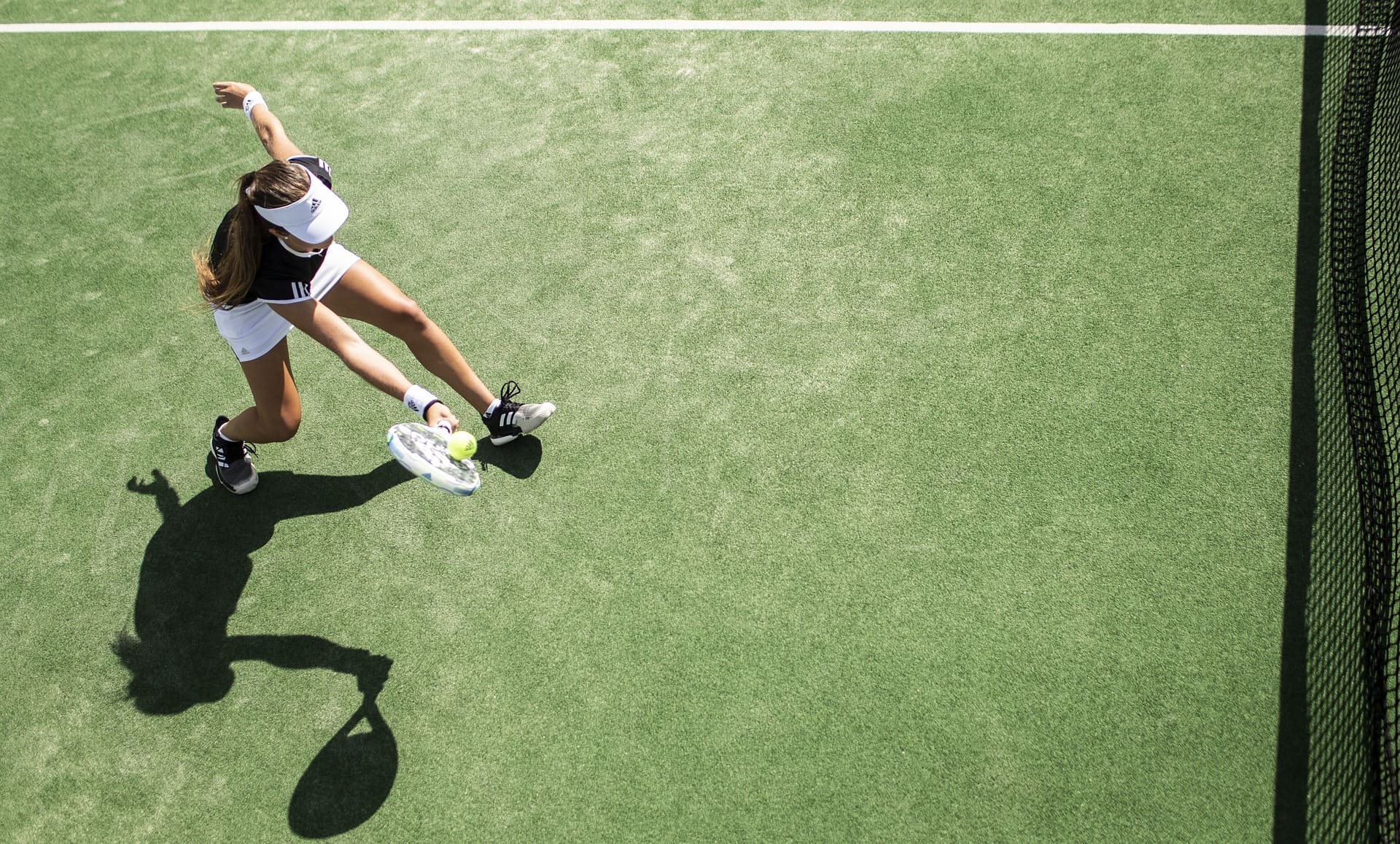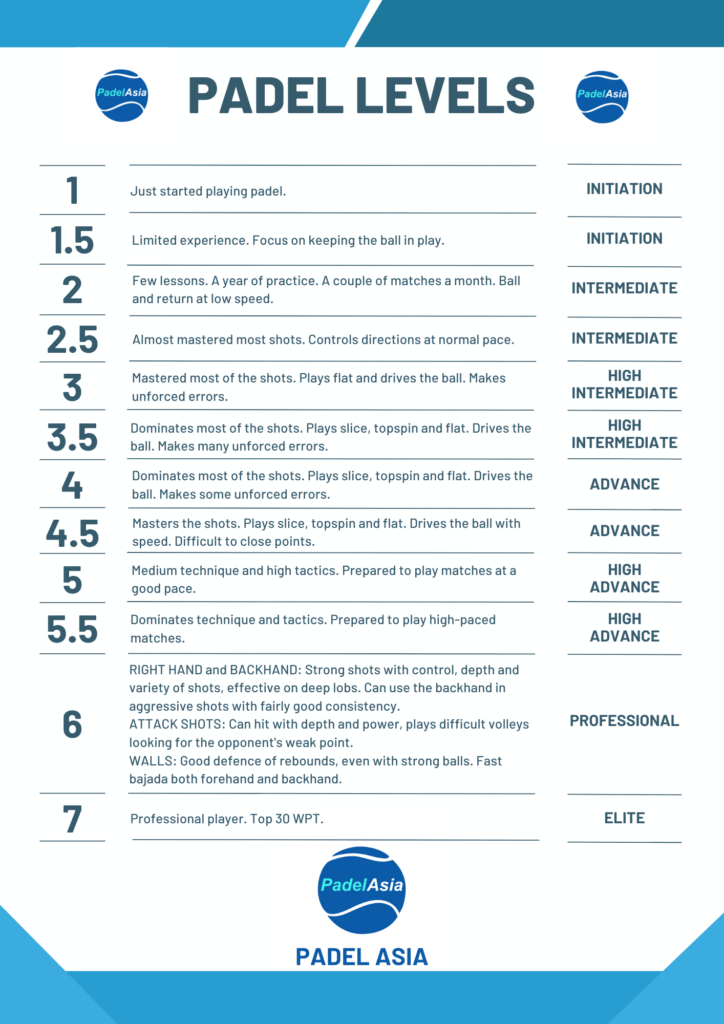August 27, 2023
What is my padel level in Asia?

PADEL LEVEL CALCULATOR IN ASIA: BOOST YOUR SKILLS AND WIN MATCHES!
1 to 7 POINTS SYSTEM DIVIDED INTO INITIATION, INTERMEDIATE, ADVANCED, AND PROFESSIONAL. MASTER YOUR RISE THROUGH THE PADEL RANKS
Understanding your padel level and having benchmarks for match preparation is crucial. That’s why we’ve crafted this guide – a unique take on evaluating your padel prowess.
The primary aim of our “Padel Level Calculator” is to offer a reference when arranging matches with unfamiliar players.
So, what is your padel level?
When someone claims, “I’m a low, mid, or high-level player,” what’s their basis? How often have we faced opponents who claimed a similar level, only for the game to be gruelling?
This predicament is all too familiar, particularly on padel forums when engaging with newcomers.
The genesis of this concept, adapted and translated from the USA’s NTRP rating system for tennis, occurred on a forum. It’s a tool that facilitates connecting with new players, setting up balanced matches.
DISCOVER YOUR PADEL LEVEL IN ASIA!
The scoring ranges from 1.0 to 7.0, and here’s how to calculate your level by yourself or you can do the Padel Asia level test:
INITIATION LEVEL
- Level 1.0
- Just started playing padel.
- Level 1.5
- Limited experience. Focus on keeping the ball in play.
INTERMEDIATE LEVEL
- Level 2.0
- FOREHAND: Incomplete swing, lacks directional control, slow ball speed.
- BACKHAND: Avoids backhand, erratic strikes, grip issues, incomplete swing.
- SERVICE/RETURN: Incomplete motion, double faults common, inconsistent ball bounce, return problems.
- VOLLEY: Avoids net, dodges backhand volley, poor foot positioning.
- REBOUNDS: Struggles with returning rebounds.
- PLAY STYLE: Familiar with basic positions, yet often mispositions.
- Level 2.5
- RIGHT HAND: Developing, moderate ball speed.
- BACKHAND: Problems in preparation and grip, often prefers the forehand shot to the backhand.
- SERVICE/RESTOW: Attempting to perform the full gesture, slow ball speed on serve, inconsistent ball bounce, slow return of serve.
- VOLLEY: Uncomfortable at the net especially on the backhand, frequently uses the face of the drive on backhand volleys.
- REBOUNDS: Tries to position himself for rebounds but only hits the ball occasionally.
- SPECIAL SHOTS: Makes intentional lobs but with little control, occasionally impales the ball on high shots (smash).
- STYLE OF PLAY: Can rally with slow ball speed, weak coverage of his space on the court, stays in the starting position of the game.
HIGH INTERMEDIATE LEVEL
- Level 3.0
- FOREHAND: Relatively consistent with moderate stroke variety, good directional control, expanding shot range (slice, flat, topspin).
- BACKHAND: Prepped for relatively consistent strikes.
- SERVICE/RETURN: Developing serve motion, inconsistent power, second serve weaker, return with moderate consistency.
- VOLLEY: Consistent forehand volley, inconsistent backhand volley, struggles with low and open hits.
- REBOUNDS: Proper positioning for slow hits, struggles with forward-moving hits.
- SPECIAL SHOTS: Moderately consistent lobs, occasional successful smashes.
- PLAY STYLE: Medium ball speed consistency, teammate positioning inconsistent, ventures net when opportune but weak execution.
- Level 3.5
- FOREHAND: Good consistency and moderate shot variety, solid directional control, evolving shot range (slice, flat, topspin).
- BACKHAND: Directional control in some shots, trouble with strong/high hits, defense struggles.
- SERVICE/RETURN: Gaining controlled serve with some power, developing slice serve, returns consistently with directional control and moderate ball speed.
- VOLLEY: More aggressive at net, fair sideline shots, solid foot positioning, directional control on forehand volleys, backhand volleys with control but less power. Time to attack!
- REBOUNDS: Proper positioning for forehand rebounds, defends moderately from forehand with moderate ball speed, struggles with quick backhand hits. Developing wall rebounds.
- SPECIAL SHOTS: Consistency in high hits, evolving drop shots, second volleys, and approach shots. Returns most second serves.
- PLAY STYLE: Consistency and directional control at medium ball speeds, moderately consistent teammate positioning (teamwork developing), seeks net-winning opportunities.
ADVANCED LEVEL
- Level 4.0
- FOREHAND: Reliable, controlled hits, aims for control in tough defensive shots.
- BACKHAND: Consistently directs ball, moderate speeds, evolving variety.
- SERVICE/RETURN: Effective, well-placed first and second serves, slice and depth, solid return with depth and control.
- VOLLEY: Control and depth on forehand volleys, backhand volley direction but lacks depth and aggressiveness. Developing low volleys.
- REBOUNDS: Consistent forehand wall hits, correct positioning for backhand rebounds. Consistent and powerful wall hits on forehand, backhand often lobs.
- SPECIAL SHOTS: Consistent high hits, aggressive volleys, starts to secure points with volleys and smashes, targets opponents’ weak areas, consistent lobs.
- PLAY STYLE: Reliable and controlled medium-to-high ball speeds, decent court coverage, adapts to opponents, aggressive net play, anticipates well.
- Level 4.5
- FOREHAND: Highly reliable, mixes speed, control, and depth, sets up net approaches. Consistent deep lobs.
- BACKHAND: Aggressive, consistent with the backhand, maintains control and depth in most hits. Solid on deep lobs and defense.
- SERVICE/RETURN: Effectively places serves, exploits opponent weaknesses, quickly moves to net, varied serves with depth, places second serves for weak returns, return consistency on challenging serves.
- VOLLEY: Precise footwork, controls net rallies, power and depth in forehand volleys, direction in backhand volleys with depth. Developing low volleys.
- REBOUNDS: Strong defense, even against powerful shots. Converts wall rebounds into winners. Effective on both forehand and backhand wall shots.
- SPECIAL SHOTS: Powerful and effective, solid defensive and offensive lobs, controlled high hits from any court position, consistent drop shots, powerful smash winners. Occasional triple bounces.
- PLAY STYLE: Consistent power, strong court coverage, adaptable strategy, aggressive net game, anticipates opponent moves.
HIGH ADVANCE LEVEL
- Level 5.0
- FOREHAND: Powerful and controlled, mixes depth and variety, sets up net plays. Consistent deep lobs.
- BACKHAND: Uses backhand aggressively with good consistency, controls direction and depth in most hits. Effective on deep lobs and defense.
- SERVICE/RETURN: Places serves effectively, exploits opponent weaknesses, quickly transitions to net, varied serves with depth, strategically places second serves, consistently handles challenging returns.
- VOLLEY: Precise footwork, controls net rallies, power and depth in forehand volleys, precise direction in backhand volleys with depth. Developing low volleys.
- REBOUNDS: Strong defensive play, even against powerful hits. Converts wall rebounds into winners. Effective on both forehand and backhand wall shots.
- SPECIAL SHOTS: Powerful and accurate, strong defensive and offensive lobs, controlled high hits from any court position, consistent drop shots, powerful smash winners. Occasionally finishes with triple bounces.
- PLAY STYLE: Consistent power, broad court coverage, adaptable tactics, aggressive net presence, anticipates opponents’ moves.
- Level 5.5
- Delivers reliable shots under pressure, anticipates well, reads matches easily to exploit opponents’ weak points, serves with depth and precision in first and second serves, developed strength and consistency, adaptable tactics in challenging situations.
PROFESSIONAL LEVEL
- Level 6.0 to 7.0
- These players transcend categories, featured in championship rankings.
- The 6.0 undergoes intensive training for regional and national tournaments, holding a national rank.
- The 6.5 possesses the potential to reach 7.0 and competes continuously in national tournaments.
- The 7.0 is the professional padel player, engages in open tournaments, and thrives on tournament winnings and sponsorships.
Fitness Adjustment Coefficient
Unfortunately in padel technical skills are not enough to fix the rating of a player.
We create a mix of the technical skills + physical conditions.
Example: 2 players with same technical skills but different psysical conditions can not have the same rating. ! player can play 3 sets and the other only 1 with the same “ball rhythm”, so they belong to different ratings (even they have the same technical skills)
Navigating an Interesting Scenario: Imagine a player who, from a technical standpoint, holds a Level 4 rank. However, due to this CORRECTIVE COEFFICIENT, their “actual” level tends to gravitate more towards Level 3 than 4. This arises from factors like: Limited physicality due to age (52 years) and lifestyle (sedentary work, padel training restricted to three times a week): diminished reflexes and reaction capacity, fatigue after an hour of play, slower movements, and more.
It’s conceivable that two players with the aforementioned conditions could compete against individuals aged 20-25, who might be inferior in technical skills but could potentially win due to their speed, agility, and endurance.
In a nutshell: Once you’ve established your level as per the guide, applying this ACCURATE COEFFICIENT based on PHYSICAL CONDITION is recommended: +1 (I’m a physical powerhouse) +0.5 (I’m in good shape) -0.5 (I’m not in the best shape) -1 (I’m a bit rusty)
So, what’s your padel level?
Now, let’s align the indicated levels with the commonly used ones, suggesting that: Here’s how I would present each level (inspired by Padel Guardian):
- Levels 1–1.5: Initiation
- Levels 2–2.5: Intermediate
- Levels 3–3.5: High Intermediate
- Levels 4–4.5: Advanced
- Levels 5–5.5: High Advance
- Levels 6–7: Professional
In summary: What’s your playing level? For a quick overview of the levels, consider this:


